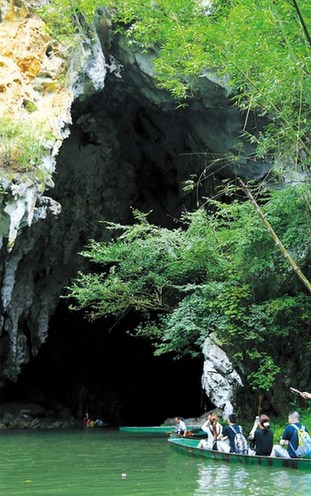Hidden away, a village evokes fabled paradise
 0 Comment(s)
0 Comment(s) Print
Print E-mail Shanghai Daily, March 16, 2017
E-mail Shanghai Daily, March 16, 2017
|
|
|
To get to Bamei Village, visitors have to take a boat trip through Taoyuan Cave. — Wang Rongjiang |
The fable written by poet Tao Qian in AD 421 described an idyllic hamlet isolated from the rest of the world, where man and nature lived in harmony. His arcadia came to be a symbol of a pastoral paradise, inspiring many Chinese artists and writers.
In Tao’s work, utopia is unattainable, but some people believe that a real-life version can be found in a subtropical area of southeastern Yunnan Province.
The destination in question is Bamei Village, about 480 kilometers from the provincial capital of Kunming.
The village is tucked away in remote mountains where no cars can go. It is connected to the outside world only through two natural limestone caves — much like the setting of Tao’s “Peach Blossom Spring.”
In fact, in the language of the local Zhuang ethnic minority, the name of the village simply means “cave opening to the forest.”
Getting to the village is a trip back in time. Visitors have to take a horse-drawn carriage to the entrance of Taoyuan Cave, where a row of wooden boats awaits alongside lush bamboo forest to complete the journey.
Like a proverbial light at the end of the tunnel, the town emerges in an idyllic vista filled with cottages, farmland and surrounding karst peaks. Hills dotted with red-brick houses take on an ethereal look whenever fog rises.
About 600 people live in Bamei. Farmers till the soil with traditional methods dating back centuries. Waterwheels straddle rivers, and wooden ploughs are pulled by water buffalo. Bamei didn’t get electricity until the mid-2000s.
In the heart of the village, a covered bridge across the Tuoniang River creates a boundary between a bathing area for men and one for women. Children can be seen frolicking naked in the river, while their mothers wash clothes nearby.
The locals lead a simple life. They are self-sufficient, growing rice and cotton, weaving their own clothes, making their own bean curd and producing their own cooking oil from rapeseed harvests.
Older women still wear the traditional white headscarves and royal-blue jackets. Some eke out a meager living by selling handmade bamboo items and snacks like caimifan, which is glutinous rice wrapped in bamboo leaves.
A small clearing in the village known as Bonfire Square serves both as a rice-drying area during sunny days and a gathering spot for locals in the evenings after work.
Spring and summer are the best times to visit Bamei. Peach blossoms, hibiscus and golden rapeseed fill the bucolic landscape during those seasons.
There’s an observation area above the village, and the 700 steps up to it are worth the effort to behold a panorama of green fields, waterways and a covered bridge.
If you go
How to get there: It takes almost four hours to fly from Shanghai to Kunming. From the capital, you need to take three buses, to Wenshan (6-7 hours), then to Guangnan (3 hours), and finally to Bamei (1-1.5 hours).
Tip: 1. You may want to leave your big suitcases behind. It’s a hassle getting them into the village.
2. Although a day trip is enough to take in everything there is to see in Bamei, an overnight stay affords the opportunity to get closer to the locals as they unwind after work.






